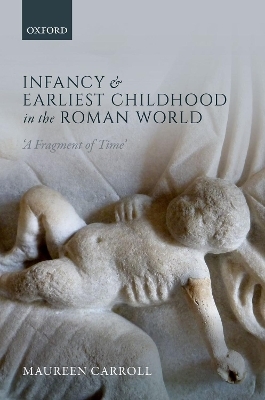
Infancy and Earliest Childhood in the Roman World
Oxford University Press (Verlag)
978-0-19-968763-3 (ISBN)
Despite the developing emphasis in current scholarship on children in Roman culture, there has been relatively little research to date on the role and significance of the youngest children within the family and in society. This volume singles out this youngest age group, the under one-year-olds, in the first comprehensive study of infancy and earliest childhood to encompass the Roman Empire as a whole: integrating social and cultural history with archaeological evidence, funerary remains, material culture, and the iconography of infancy, it explores how the very particular historical circumstances into which Roman children were born affected their lives as well as prevailing attitudes towards them. Examination of these varied strands of evidence, drawn from throughout the Roman world from the fourth century BC to the third century AD, allows the rhetoric about earliest childhood in Roman texts to be more broadly contextualized and reveals the socio-cultural developments that took place in parent-child relationships over this period. Presenting a fresh perspective on archaeological and historical debates, the volume refutes the notion that high infant mortality conditioned Roman parents not to engage in the early life of their children or to view them, or their deaths, with indifference, and concludes that even within the first weeks and months of life Roman children were invested with social and gendered identities and were perceived as having both personhood and value within society.
Maureen Carroll is Professor of Roman Archaeology at the University of Sheffield and is also a founding member of its Centre for the Archaeology of Childhood. She studied Classical Archaeology in Canada, the USA, and Germany, and was the recipient of the prestigious Balsdon Fellowship and the Hugh Last Fellowship at the British School at Rome in 2008 and 2016 respectively. She has published widely on infant death and burial in Roman Italy, on Roman funerary commemoration, and on Roman gardens, and has conducted excavations at major sites in the Roman world, including Pompeii and Vagnari in Italy and Cologne in Germany.
Frontmatter
List of Figures
List of Abbreviations
Maps
1: Introduction
1.1: Locating Children in the Roman Family
1.2: Roman Infancy: Developing a Research Theme
1.3: Aim and Organization of this Study
2: Infants and Children in Pre-Roman Mediterranean Societies
2.1: Infant Death and Burial
2.1.1: Location and Method of Disposal: Cultural Differences
2.1.2: Grave Goods for Infants
2.2: Pregnancy and Childbirth in Pre-Roman Art
2.3: Images of Infants and the Family in Life and Death
2.4: Infants and the Divine in the Greek World
3: Mother and Child: Pregnancy, Birth, and Health
3.1: Fetal Development in the Womb
3.2: Childbirth and Death in Childbirth
3.3: The Life Course: Milestones in the First Year of Life
3.4: Health and Disease of Infants: The Bioarchaeological Evidence
3.5: Divine Protection of the Infant
4: The Material Culture of Infancy
4.1: Feeding Bottles
4.2: Clothing
4.3: Cribs, Cradles, and Blankets
4.4: Apotropaic Jewellery
4.5: Pets and Toys
5: Picturing Infants and Families in Roman Art
5.1: Imperial and Ideological Images of Roman Infants and Families
5.2: Barbarian Parents and Infants
5.3: Biographical Sarcophagi and Vignettes of Roman Family Life
5.4: Portraits and Statues of Infants
6: Mors Immatura I: Contextualizing the Death and Burial of Infants
6.1: Infant Mortality and Age at Death
6.2: Burial Sites of Infants: Integration or Exclusion?
6.2.1: Infant Burials in Communal Cemeteries
6.2.2: Infant Burials in Settlements and Buildings
6.2.3: Infant Burials in Roman Forts
6.3: Infant Sacrifice, Infanticide, and Exposure
7: Mors Immatura II: The Treatment of the Infant Body in Death
7.1: Marseille: Greek and Roman Burials in Cultural Comparison
7.2: Cremation vs. Inhumation . . . and Mummification
7.3: Containers, Coffins, and Wrappings for the Infant Body
7.4: Investment and Expense
7.5: Grave Goods and Offerings
8: Funerary Commemoration of Infants
8.1: Age at Death in Epitaphs
8.2: Expressions of Grief and Loss
8.3: Funerary Images of Infants
8.4: Mother and Infant Commemorated
8.5: Children and the Social Status of the Family
9: Integrated Perspectives on Roman Infancy
9.1: Re-Evaluating Laws on Mourning
9.2: Compensating for Lives Unlived?
Appendix: Tables 1-8
Endmatter
Bibliography
Index
| Erscheinungsdatum | 29.03.2018 |
|---|---|
| Zusatzinfo | 86 black-and-white illustrations and 2 maps |
| Verlagsort | Oxford |
| Sprache | englisch |
| Maße | 163 x 243 mm |
| Gewicht | 724 g |
| Themenwelt | Geisteswissenschaften ► Archäologie |
| Geschichte ► Allgemeine Geschichte ► Vor- und Frühgeschichte | |
| Geschichte ► Allgemeine Geschichte ► Altertum / Antike | |
| Geisteswissenschaften ► Geschichte ► Regional- / Ländergeschichte | |
| Geschichte ► Teilgebiete der Geschichte ► Kulturgeschichte | |
| Geisteswissenschaften ► Sprach- / Literaturwissenschaft ► Anglistik / Amerikanistik | |
| Sozialwissenschaften ► Soziologie | |
| ISBN-10 | 0-19-968763-3 / 0199687633 |
| ISBN-13 | 978-0-19-968763-3 / 9780199687633 |
| Zustand | Neuware |
| Haben Sie eine Frage zum Produkt? |
aus dem Bereich


